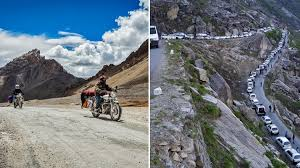Infrastructure push is now no longer a slogan. A series of tunnels are being constructed on the Manali–Leh Highway. The Atal Tunnel, located under the Rohtang Pass ahead of Manali, is already operational. Another tunnel is under construction at Baralacha La on the Himachal–Ladakh border.
The work is on under Tangang La and Lachung La in Ladakh. These three to four all-weather passes, situated at sufficiently high altitudes, fortify the security axis.
All of these tunnels are part of the India-China Border Roads Initiative.
Prime Minister Narendra Modi's recent visit to Jammu and Kashmir marked a milestone as he inaugurated the Z-Morh Tunnel near Sonamarg.
This will open a new chapter in connectivity, security and economic growth.
Ladakh’s rugged terrain and harsh winters often left it cut off from the rest of the country for nearly six months in a year. Heavy snow fall shut the Srinagar-Leh highway.
This would impact basic public services - health care and education. The Z-Morh Tunnel now will end this isolation.
This 6.5-kilometre-long tunnel, a key component of a strategic Srinagar-Leh National Highway, links Gagangir and Sonamarg continuously year-round.
Since the tunnel is 2 637 m high, the travel and so the time is remarkably reduced.
The Leh–Manali Highway is a 428 km (266 mi) long highway in northernmost India connecting Leh, the capital of the Union Territory of Ladakh, to Manali in the state of Himachal Pradesh. It crosses four passes: Rohtang La, Baralacha La, Lungalacha Ka, Tanglang La.
It connects the Kullu Valley of the upper Beas river to the Chandra and Bhaga river valleys of Lahaul via the Atal tunnel in Himachal Pradesh, then crosses over a series of high Himalayan passes into the Indus river valley in Ladakh.
It is usually open for about six months a year from the first week of May when the snow is cleared from the highway to October.
"Apart from the excellence of its engineering, the Z-Morh Tunnel is a source of life for the people, a source of boost to the local economy, and a strategic asset for the national security of India," says an article in 'Brighter Kashmir'.
"Three major visits by India’s Prime Minister to Jammu and Kashmir between February 2024 and January 2025 have marked monumental progress in infrastructure development. Roads, railways, power projects, bridges, ropeways, medical institutes, and lower and higher education facilities have all materialised.
This demonstrates the current government’s intent and determination to address decades of neglect by previous administrations," writes longtime J&K watcher Farooq Wani for 'News18'.
From its commencement in October 2012 to its completion in January 2025, this project has experienced its share of ups and downs, which were overcome through the phenomenal grit and determination displayed by everyone involved. Difficult terrain and adverse climatic conditions weren’t the only challenges—given the massive capital outlay of the project, its financial management was also an exacting issue.
According to Wani yet again, "Few are aware that the initial executing concessionaire, Infrastructure Leasing & Financial Services (IL&FS), had to quit the project midway due to financial stress after taking it on in 2015.
It then took the government almost two years to find a new concessionaire. The project was supervised by the National Highways Authority of India (NHAI) and the Border Roads Organisation (BRO)."
It must be noted that previously, due to the closure of roads for much of the year, troops deployed in these regions were heavily reliant on air-based maintenance.
Thus with the development of all-weather roads and forward landing strips, the operational and administrative constraints caused by adverse weather conditions have been significantly mitigated.
Round-the-year troop deployment and access reduce reaction times, enabling faster and more cost-effective mobilisation and force accretion to address rapidly evolving threats. However, beyond enhancing India’s defence capability, infrastructure development in these regions also meets the needs and aspirations of the local population.
For Ladakh, the Z-Morh Tunnel now means hope and access to it guarantees a continuous supply of, for example food, fuel, and medication, which often were unavailable in winter season.
Education and career opportunities are now more readily accessible to students and professionals for them to move about and travel to pursue their aims, thereby promoting a feeling of inclusion and national integration.
Border infrastructure along the Sino-Indian border, which has several border areas disputed by both India and China, encompasses irrigation, roads, railways, airports, natural gas and oil pipelines, electricity grids, telecommunications, and broadcasting.
In the context of the border tensions between India and China, many of these infrastructure projects in the borderlands are considered strategic in nature.
For many decades, the approach taken to the construction of border infrastructure by China and India was significantly different,
However, in terms of utilizing the natural resources of the borderlands for the needs of the country, both countries are said to have a similar approach.
ends








No comments:
Post a Comment